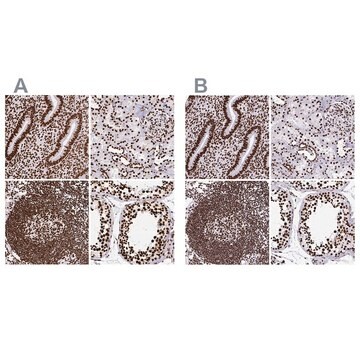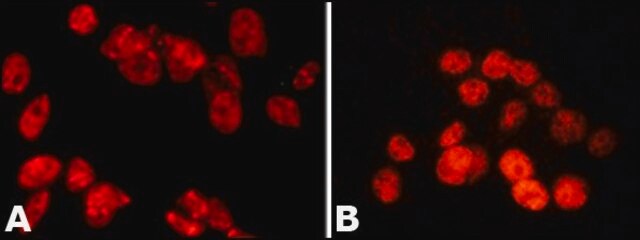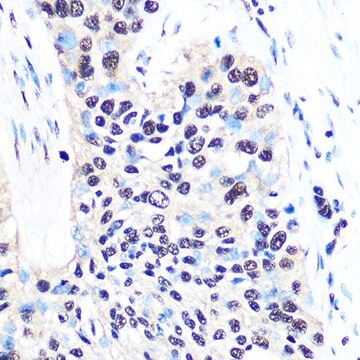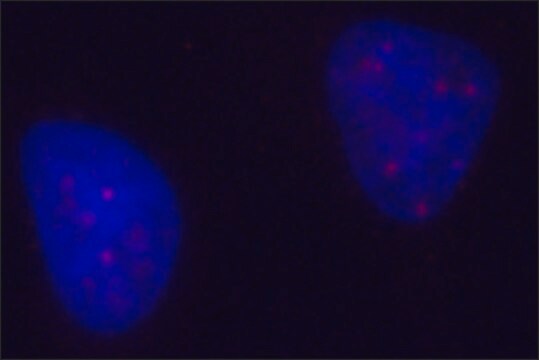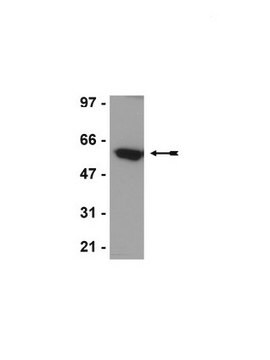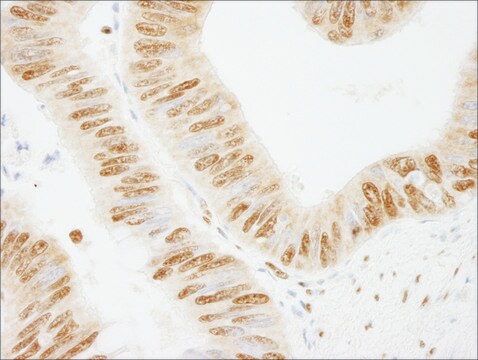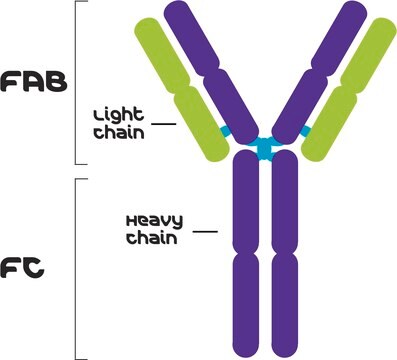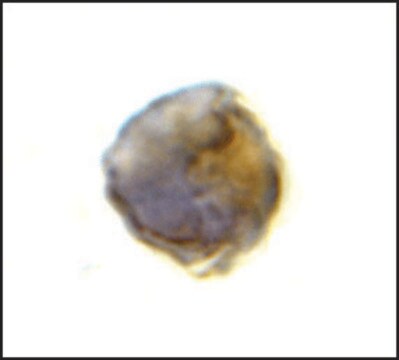추천 제품
생물학적 소스
mouse
Quality Level
결합
unconjugated
항체 형태
purified from hybridoma cell culture
항체 생산 유형
primary antibodies
클론
FC23, monoclonal
양식
buffered aqueous solution
분자량
antigen ~95 kDa
종 반응성
rat, human, mouse
농도
~1.0 mg/mL
기술
indirect immunofluorescence: 10-20 μg/mL using HeLa cells.
western blot: 0.5-1 μg/mL using Whole extracts of mouse Hepa1-6 cells.
동형
IgG2a
UniProt 수납 번호
배송 상태
dry ice
저장 온도
−20°C
타겟 번역 후 변형
unmodified
유전자 정보
human ... SFPQ(6421)
mouse ... Sfpq(71514)
rat ... Sfpq(252855)
유사한 제품을 찾으십니까? 방문 제품 비교 안내
일반 설명
Splicing factor proline and glutamine rich (SFPQ), also known as polypyrimidine tract-binding protein-associated-splicing factor (PSF), is a multifunctional nuclear protein. It is encoded by the gene mapped to human chromosome 1p34. The encoded protein is characterized with an N-terminal glycine rich domain, a proline/glutamine-rich domain (P/Q), two RNA recognition motifs (RRMs) and a C-terminal region with two nuclear localization signals.
Splicing factor, praline- and glutamine-rich (SFPQ), also known as PSF, is a member of the DBHS (Drosophila behaviour, human splicing) protein family, consisting also of PSPC1 (paraspeckle protein 1) and NONO (non-POU-domain-containing, octamer binding protein). The DBHS proteins localizes between the nucleoplasm, paraspeckles and the nucleolus. Monoclonal Anti-SFPQ (mouse IgG2a isotype) is derived from the hybridoma FC23 produced by the fusion of mouse myeloma cells and splenocytes from BALB/c mice immunized with a synthetic peptide corresponding to a sequence at the C-terminal region of mouse SFPQ, conjugated to keyhole limpet hemocyanin (KLH).
면역원
Synthetic peptide corresponding to a sequence at the C-terminal region of mouse SFPQ, conjugated to KLH. The corresponding sequence is identical in rat and human.
애플리케이션
Monoclonal Anti-SFPQ antibody produced in mouse has been used in immunoblotting and immunofluorescence.
생화학적/생리학적 작용
Drosophila behaviour, human splicing (DBHS) proteins are involved in several biological processes such as regulation of circadian rhythm, carcinogenesis and cancer progression. SFPQ activates androgen receptor mediated transcription.
Splicing factor proline and glutamine rich (SFPQ) along with its binding partner non-POU domain-containing octamer-binding protein (NONO/p54nrb), plays a vital role in RNA processing, RNA splicing and transcriptional regulation. Additionally, these proteins also play a crucial role in various regulatory roles including, selective nuclear retention of defective mRNAs. SFPQ participates in transcription repression by recruiting transcription regulator proteins Sin3a and histone deacetylase (HDAC).
물리적 형태
Solution in 0.01 M phosphate buffered saline, pH 7.4, containing 15 mM sodium azide.
면책조항
Unless otherwise stated in our catalog or other company documentation accompanying the product(s), our products are intended for research use only and are not to be used for any other purpose, which includes but is not limited to, unauthorized commercial uses, in vitro diagnostic uses, ex vivo or in vivo therapeutic uses or any type of consumption or application to humans or animals.
적합한 제품을 찾을 수 없으신가요?
당사의 제품 선택기 도구.을(를) 시도해 보세요.
Storage Class Code
10 - Combustible liquids
WGK
WGK 2
Flash Point (°F)
Not applicable
Flash Point (°C)
Not applicable
가장 최신 버전 중 하나를 선택하세요:
The t(1;9)(p34;q34) and t(8;12)(p11;q15) fuse pre-mRNA processing proteins SFPQ (PSF) and CPSF6 to ABL and FGFR1.
Hidalgo-Curtis C
Genes Chromosomes Cancer, 47, 379-385 (2008)
Arginine methylation and citrullination of splicing factor proline- and glutamine-rich (SFPQ/PSF) regulates its association with mRNA
Snijders AP
RNA, 21, 347-359 (2015)
Structure of the heterodimer of human NONO and paraspeckle protein component 1 and analysis of its role in subnuclear body formation
Passon DM, et al.
Proceedings of the National Academy of Sciences of the USA, 109(13), 4846-4850 (2012)
Paraspeckles: nuclear bodies built on long noncoding RNA
Bond S and Fox AH
The Journal of Cell Biology, 186(5), 637-644 (2009)
PSPC1, NONO, and SFPQ are expressed in mouse Sertoli cells and may function as coregulators of androgen receptor-mediated transcription
Kuwahara S, et al.
Biology of Reproduction, 75(3), 352-359 (2006)
자사의 과학자팀은 생명 과학, 재료 과학, 화학 합성, 크로마토그래피, 분석 및 기타 많은 영역을 포함한 모든 과학 분야에 경험이 있습니다..
고객지원팀으로 연락바랍니다.